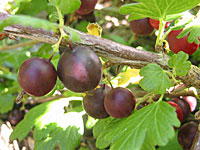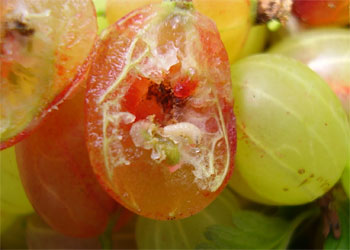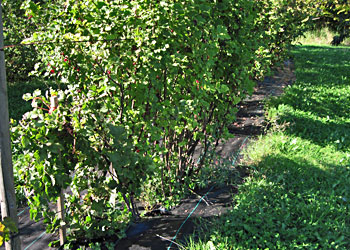Intern Profile: Lily Morgan
Lily is a student at Fairhaven College at Western Washington University. So she could commit to 40 hours a week for eight months, Lily took spring and fall quarters off from school in order to participate in Cloud Mountain’s internship program. A native of Portland, Ore., she moved north to attend college. Her studies are focused on the social implications of agricultural systems and international trade.
At school, she discovered The Outback Farm, an on-campus, five-acre experiential learning site. She completed a summer-long apprenticeship with the farm, growing food for the local food bank. “I wanted an internship where I could ask questions, work in the fields, and get guidance,” she said. “I appreciate the length of this program. We get to experience working on the farm for full seasons, not just for weeding and harvesting.” She had become familiar with Cloud Mountain while volunteering at our annual fall fruit festival and, after figuring out how to juggle being a student and a full-time intern, she decided to pursue the internship program.
After the internship, she’ll be taking her knowledge and experience with her to South America for a year, where she’ll be working on cocoa and coffee fields. Her trip is being sponsored with a scholarship she was awarded by Fairhaven College. She hopes her experiences during her travels will further expand her understanding of how agriculture functions on a local and global scale. The biggest question she wants to explore, both at Cloud Mountain and in her studies is: “How can we create an agricultural system where people can make a comfortable living and still be stewards of the ecosystem?”
Lily’s Project: Currants and Gooseberries

Black Velvet Gooseberry
With projects up to the neck here already at Cloud Mountain, I chose to focus on an area of the farm that was not being prioritized. My interests going into the internship were in marketing and perennial crops. I saw the more than thirty gooseberry and currant plants that had been established in the field for a number of years as a chance to see a perennial crop through a season and to the consumer. I jumped into the care and maintenance of the gooseberries and currants with very little knowledge of what that entailed.

Gooseberry maggot
Soon I was researching “gooseberry maggot,” “currant worm,” and “organic pest control for gooseberries.” The gooseberry maggot, or gooseberry-currant fruit fly, is a pest that has built up a population here on the farm in past years. The fly is bothersome due to its nature of laying eggs in unripe fruit, which then rots as the larvae matures inside, ruining one’s crop. The larvae will pupate and drop into the soil to overwinter and emerge the following spring, sometime around mid April.
I came about this from the marketing end, imagining how the consumer would want their fruit treated. Taking this, and my own ambition to follow organic practices into account, I began searching for reliable ways to combat this pest. (Many of the resources regarding gooseberry and currant pest management date back to the 1920s and 30s—a little outdated!) The WSU IPM (integrated pest management) recommendation is to screen new or uninfested plantings with floating row cover and secure around to the base of the plant, effectively creating a barrier before adult flies emerge. This may be a method that the home gardener or small grower with just a few plants could employ, but it became clear that it would not pencil- out to individually wrap each of our plants in a 200 ft+ row. Another suggestion was to pick and destroy all infested fruit on a daily basis. This being impractical, and the clock ticking on the fly’s reproductive cycle, I experimented with using a number of organic pesticide sprays applied manually with a backpack sprayer. While I do feel that these applications were effective, I discovered that timing the first application before the emergence of the adult flies is crucial, as well as adhering to a regular regimen of spraying according the organic pesticide label. Ideally, I would not be using any sprays at all, but I came to understand that with a perennial crop comes the issue of pest pressures that build up over years, and once you have a problem, more heavy-handed measures are necessary to eradicate a pest population.
I talked to other local growers regarding their pest management with gooseberries and currants, and encountered a range of approaches, from flaming the rows, to releasing poultry to feed on the insects in the area of the planting. I would like to try both of these methods, but currently the infrastructure at Cloud Mountain does not allow for it. There will likely be a flamer around next year and I plan on providing a write-up of my pest management trials so that hopefully a future intern will take the gooseberries and currants under their wing.
Much of this year’s crop did become infested with the gooseberry maggot, but I was able to salvage some of the crop and involve myself a little in the marketing side of things. Between the farmer’s market, calls into the farm, and local chefs and bakers, we received more requests for gooseberries and currants than we could supply. Thus I believe that these are viable and profitable crops for local growers, but only when accompanied by an established management plan. For the remainder of the season I have placed heavy landscape cloth beneath one of the rows as a barrier to larvae attempting to pupate into the soil. I have also worked to prune the plants into a more up-right, fan shape, and clear, open base to allow air flow and better cover/adherence of any spray applications.

Landscape cloth row covers
This project became much more about managing a pest population, and less about marketing than I had imagined. But I feel I am coming away with a better understanding of not only the challenges associated with growing a perennial small-fruit crop, but also the benefits—you get to try again next year! In the end, these fruits really do flourish in this climate, and I saw and tasted the diversity of varietals and culinary possibilities. The plants look great, the staff has heard me bugging them about gooseberries and currants that there’s no way they’ll forget them, and there’s sure to be a bountiful crop next year. Like any project, I am left with a few ideas of how I, and hopefully those after me, could do things differently: Be on high alert for the emergence of adult flies in the spring—check for puncture wounds in the fruit, signs of the flies themselves, and consult the WSU and OSU pest management sites for detailed information; If applying sprays, be sure to have the plants pruned to allow full coverage, and the base of the plants free of any branches or weeds. Despite the difficulties, I think there is a great niche in currant and gooseberry production in the Pacific North West.

